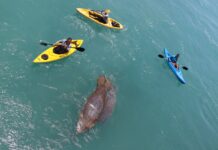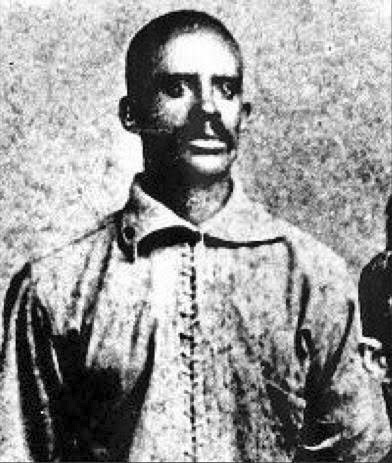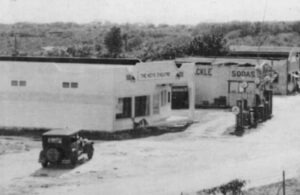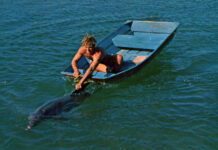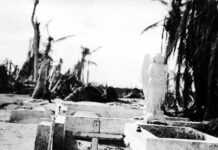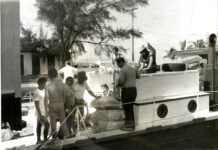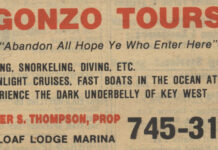Nearly 100 years after the African chieftain who became the original Black Caesar was hanged for piracy, allegedly, he returned. Well, he returned in name. This second Black Caesar is generally identified as either Henri Caesar or Henri Arnaut. Henri was a slave owned by the Arnaut family who lived in Haiti.
Stories suggest Henri was born circa 1765. He grew up to be a strong plantation worker, a natural leader who rose to power during the Haitian slave revolt (1791-1803ish). According to his legendary story, it was circa 1805 when he stole a Spanish ship, sailed away, and embarked on a piratical career using the name Black Caesar. He operated from a lair on Elliott Key.
The original Black Caesar is said to have dangled at the end of a hangman’s noose after he was apprehended by Lt. Maynard’s British forces in the November 22, 1718 raid on Blackbeard’s sloop Adventure. The demise of the Henri Caesar version of Black Caesar is decidedly less apparent. Several stories suggest he abandoned Elliott Key because of increased naval patrols in the area due to the War of 1812.
From Elliott Key, most of the stories say Black Caesar set sail for the Gulf of Mexico where he organized his pirate operation on Southwest Florida’s Sanibel Island. Unlike his predecessor, this Black Caesar pirate story has many endings. One account is that the pirate was killed when he attempted to board a disguised Navy ship. Another says that in 1817 the pirate Jose Gaspar and Black Caesar began feuding when Black Caesar stole one of Gaspar’s women.
Subsequently, Black Caesar was vanquished from Sanibel. From there, he either a.) sailed off into the Gulf of Mexico and disappeared; b.) was killed by a woman after he boarded a ship out in the Gulf of Mexico; or c.) sailed for Australia.
There is an Australian Black Caesar story. John Black Caesar was found guilty of theft while living in England and sentenced to seven years in an Australian penal colony. He was transported aboard the Alexander, part of the First Fleet of convicts shipped to penal colonies established in Australia. Caesar arrived in Botany Bay in January 1788.
A newspaper account dated seven years later, on March 25, 1795, reads: “Bushranger on the loose! Born in Madagascar in 1770, notorious Black Caesar is the first so-called ‘bushranger’ [an outlaw or highwayman] to inhabit this Great South Land. He robs people because he claims not to have enough to eat. He is a tall, strong, negro who wears convict clothing. Five gallons of rum will be the reward to the person who gives information leading to the capture of Black Caesar.”
While John Black Caesar was not a pirate, his actions were certainly piratical. It should be noted that of all the Black Caesars thus far mentioned, John Black Caesar is the only one with contemporary stories written about him to support his authenticity.
Back in the Florida Keys, if anyone were going to tell a 19th century Black Caesar story, it would have been Temple Pent. One of the early pioneers to settle in South Florida, Pent arrived in the Coconut Grove area as early as 1810. Had a pirate as notorious as Black Caesar been conducting raids in the Northern Keys from an Elliott Key lair, Pent would have had firsthand knowledge of the pirate’s shenanigans.
When Commodore David Porter of the West Indies Squadron, the anti-piracy unit, arrived in 1823, Pent became his pilot. Porter, whose job was to rid the West Indies of pirates, makes no contemporary record of a pirate named Black Caesar, dead or alive. The same can be said of Temple Pent. There is, however, a Pent who allegedly talked about Black Caesar.
Boe Pent is attributed with a compelling story. He is said to have been born in 1810, on Key West, where he lived to be 105 years old. As a boy, Boe Pent claimed to have met Black Caesar. In his account, the pirate had been an African chieftain captured by slave traders who survived a hurricane and washed up on Elliott Key. His story describes the Black Caesar who landed in the early 18th century and was captured aboard Blackbeard’s sloop.
Upon closer inspection, Boe Pent’s account is a blending of both Black Caesars associated with Elliott Key, though 100 years separate the two. Boe Pent, himself, is a challenging character. Beyond a second-hand retelling of an overheard story, there seems to be no documentation of a man named Boe Pent. The only Pent born in 1810 was James Edward Anthony Pent who died, in Key West, on May 19, 1864.
What makes the Black Caesar story such a legendary tale is not just that it spans more than a century but that it has been retold so many times that it has rooted itself quite snugly into the lore of the Florida Keys. More than 200 years of time, tide, hurricanes, and archaeological exploration have yet to reveal any evidence of a pirate encampment or the treasure each of these two pirates is alleged to have buried on Elliott Key—but it is a great story.





